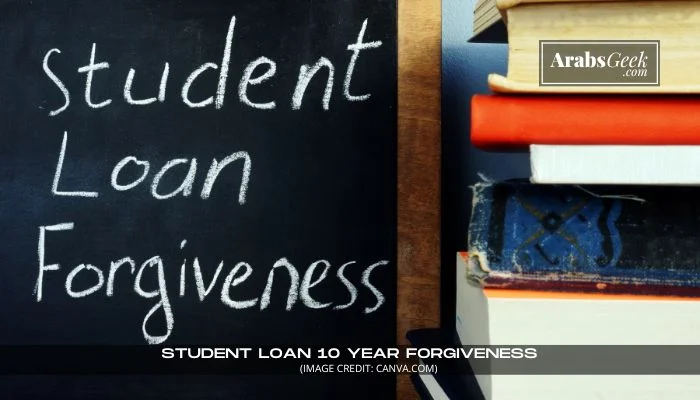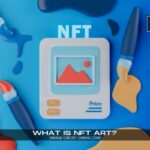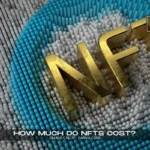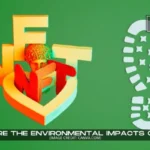Student loans are a means to an end for many students seeking to achieve higher education. However, the burden of paying off student loans can be overwhelming, especially for those who have just graduated and are starting their careers. In recent years, the issue of student loan forgiveness has been gaining attention, and one of the options available is the Student Loan 10 Year Forgiveness program.
Table of Contents
Understanding Student Loan 10 Year Forgiveness
The 10-Year Student Loan Forgiveness program is a federal student loan forgiveness program that allows borrowers to have their student loans forgiven after making 120 qualifying payments over ten years. This program is also known as the Public Service Loan Forgiveness (PSLF) program. It is available to those who work in public service jobs or for nonprofit organizations.
For any business enquiry, you can contact us at ArabsGeek.com
For more of such financial articles, Consider visiting our sister website at EntrepreneursPilot.com
Eligibility Criteria for Student Loan 10 Year Forgiveness
To be eligible for the 10-Year Student Loan Forgiveness program, you must meet certain criteria, including:
- You must have Direct Loans or Federal Stafford Loans (subsidized or unsubsidized).
- You must be working full-time for a qualifying public service organization or nonprofit organization.
- You must have made 120 qualifying payments under a qualifying repayment plan.
- You must have remaining loan balances after 10 years of repayment.
Types of Student Loans Eligible for Forgiveness
Under the 10-Year Student Loan Forgiveness program, Direct Loans, and Federal Stafford Loans (subsidized or unsubsidized) are eligible for forgiveness. However, Parent PLUS Loans, Federal Perkins Loans, and private student loans are not eligible.
Payment Plans under Student Loan 10 Year Forgiveness
To qualify for the 10-Year Student Loan Forgiveness program, you must make 120 qualifying payments under a qualifying repayment plan. There are several repayment plans available, including the Standard Repayment Plan, Graduated Repayment Plan, Income-Contingent Repayment Plan (ICR), and Income-Based Repayment Plan (IBR).
Pros and Cons of Student Loan 10 Year Forgiveness
Like any other program, the 10-Year Student Loan Forgiveness program has its advantages and disadvantages.
Advantages of Student Loan 10 Year Forgiveness
- Forgiveness of remaining loan balances after 10 years
- Payment plans based on your income, making it easier for you to repay your loans
- Opportunity to work in public service jobs or for nonprofit organizations
- Potential tax benefits on the forgiven loan amount
- Disadvantages of 10-Year Student Loan Forgiveness
- Limited eligibility criteria for borrowers
- Not all types of student loans are eligible for forgiveness
- Required qualifying payments for ten years can be a long time for some borrowers
- There is no guarantee that the program will continue in the future.
- How to Apply for 10-Year Student Loan Forgiveness
- To apply for the 10-Year Student Loan Forgiveness program, you must follow these steps:
- Make sure you meet the eligibility criteria for the program.
- Choose a qualifying repayment plan and make 120 qualifying payments over ten years.
- Submit the Employment Certification Form annually to ensure that your employer qualifies.
- After ten years of repayment, submit the forgiveness application form.
- Documents Required for Applying for 10-Year Student Loan Forgiveness
- When applying for 10-Year Student Loan Forgiveness, you will need the following documents:
- Employment Certification Form
- Income tax returns
- Pay stubs
- Loan statements
What documents are required to apply for Student Loan 10 Year Forgiveness?
To apply for 10-Year Student Loan Forgiveness, you will need the Employment Certification Form, income tax returns, pay stubs, and loan statements.
What are some alternatives to Student Loan 10 Year Forgiveness?
Alternatives to 10-Year Student Loan Forgiveness include Income-Driven Repayment Plans, Public Service Loan Forgiveness (PSLF), and state-based student loan forgiveness programs.
What is an Income-Driven Repayment Plan?
An Income-Driven Repayment Plan is a plan that sets your monthly payment amount based on your income to help you manage your student loan debt. Some examples of Income-Driven Repayment Plans include the Income-Based Repayment Plan (IBR), Pay As You Earn (PAYE) Plan, and Revised Pay As You Earn (REPAYE) Plan.
What is the Public Service Loan Forgiveness (PSLF) program?
The Public Service Loan Forgiveness (PSLF) program is a federal student loan forgiveness program that forgives the remaining balance on eligible Direct Loans after you have made 120 qualifying payments while working for a qualifying employer.
What are state-based student loan forgiveness programs?
Some states offer student loan forgiveness programs for those who work in specific fields or areas. For example, the New York State Loan Forgiveness Program offers loan forgiveness to those who work in health care or teaching in certain areas in the state.
Other Alternatives to Student Loan 10 Year Forgiveness
If you do not qualify for the 10-Year Student Loan Forgiveness program or want to explore other options, you can consider the following alternatives:
Income-Driven Repayment Plans
- Income-Driven Repayment Plans are designed to help borrowers manage their student loan debt by setting their monthly payment amount based on their income. There are several types of Income-Driven Repayment Plans, including the Income-Based Repayment Plan (IBR), Pay As You Earn (PAYE) Plan, and Revised Pay As You Earn (REPAYE) Plan.
Public Service Loan Forgiveness (PSLF)
- The Public Service Loan Forgiveness (PSLF) program is another federal student loan forgiveness program that forgives the remaining balance on eligible Direct Loans after you have made 120 qualifying payments while working for a qualifying employer. The eligibility criteria for PSLF are similar to the 10-Year Student Loan Forgiveness program.
State-Based Student Loan Forgiveness Programs
- Some states offer student loan forgiveness programs for those who work in specific fields or areas. For example, the New York State Loan Forgiveness Program offers loan forgiveness to those who work in health care or teaching in certain areas in the state.
Conclusion
The Student Loan 10 Year Forgiveness program is a federal student loan forgiveness program that allows borrowers to have their remaining loan balances forgiven after ten years of qualifying payments. To be eligible, borrowers must have Direct Loans or Federal Stafford Loans, work full-time for a qualifying public service or nonprofit organization, make 120 qualifying payments, and have remaining loan balances after ten years.
While there are some advantages to the program, such as payment plans based on income and potential tax benefits, there are also some disadvantages, such as limited eligibility criteria and uncertainty about the program’s future. However, if you do not qualify for this program, there are alternatives to consider, such as Income-Driven Repayment Plans, Public Service Loan Forgiveness (PSLF), and state-based student loan forgiveness programs.
Frequently Asked Questions (FAQs)
01. What is student loan forgiveness?
Student loan forgiveness is a program that allows borrowers to have their student loans forgiven after a certain period or under certain circumstances. Student loan forgiveness is a program that allows borrowers to have some or all of their student loan debt forgiven. This means that the borrower no longer has to pay back the remaining balance of their loans. There are various types of student loan forgiveness programs available, including those for public service employees and those with certain types of loans.
02. What are the eligibility criteria for Student Loan 10 Year Forgiveness?
To be eligible for the 10-Year Student Loan Forgiveness program, you must have Direct Loans or Federal Stafford Loans (subsidized or unsubsidized), work full-time for a qualifying public service organization or nonprofit organization, have made 120 qualifying payments under a qualifying repayment plan, and have remaining loan balances after ten years of repayment.
To be eligible for 10-Year Student Loan Forgiveness, you must have Direct Loans or Federal Stafford Loans, work full-time for a qualifying public service or nonprofit organization, make 120 qualifying payments, and have remaining loan balances after ten years.
03. What are the types of student loans eligible for forgiveness under Student Loan 10 Year Forgiveness?
Under the 10-Year Student Loan Forgiveness program, Direct Loans and Federal Stafford Loans (subsidized or unsubsidized) are eligible for forgiveness.
The types of student loans eligible for forgiveness under 10-Year Student Loan Forgiveness include Direct Loans and Federal Stafford Loans. However, other types of loans, such as Parent PLUS Loans and Perkins Loans, are not eligible for this program.
04. What are the payment plans under Student Loan 10 Year Forgiveness?
There are several repayment plans available under the 10-Year Student Loan Forgiveness program, including the Standard Repayment Plan, Graduated Repayment Plan, Income-Contingent Repayment Plan (ICR), and Income-Based Repayment Plan (IBR).
The payment plans under 10-Year Student Loan Forgiveness include Standard Repayment Plan, Graduated Repayment Plan, and Income-Driven Repayment Plan. Income-Driven Repayment Plans set your monthly payment amount based on your income to help you manage your student loan debt.
05. What are the pros and cons of Student Loan 10 Year Forgiveness?
The advantages of 10-Year Student Loan Forgiveness include forgiveness of remaining loan balances after ten years, payment plans based on income, and potential tax benefits. The disadvantages include limited eligibility criteria, not all types of loans being eligible, a long time for required qualifying payments, and uncertainty about the program’s future.
The advantages of 10-Year Student Loan Forgiveness include loan forgiveness after ten years, payment plans based on income, and potential tax benefits. The disadvantages include limited eligibility criteria, not all types of loans being eligible, a long time for required qualifying payments, and uncertainty about the program’s future.
06. What documents are required to apply for Student Loan 10 Year Forgiveness?
To apply for 10-Year Student Loan Forgiveness, you will need the Employment Certification Form, income tax returns, pay stubs, and loan statements.
07. What are some alternatives to Student Loan 10 Year Forgiveness?
Alternatives to 10-Year Student Loan Forgiveness include Income-Driven Repayment Plans, Public Service Loan Forgiveness (PSLF), and state-based student loan forgiveness programs. Income-Driven Repayment Plans set your monthly payment amount based on your income to help you manage your student loan debt. PSLF forgives the remaining balance on eligible Direct Loans after you have made 120 qualifying payments while working for a qualifying employer. Some states offer student loan forgiveness programs for those who work in specific fields or areas.











